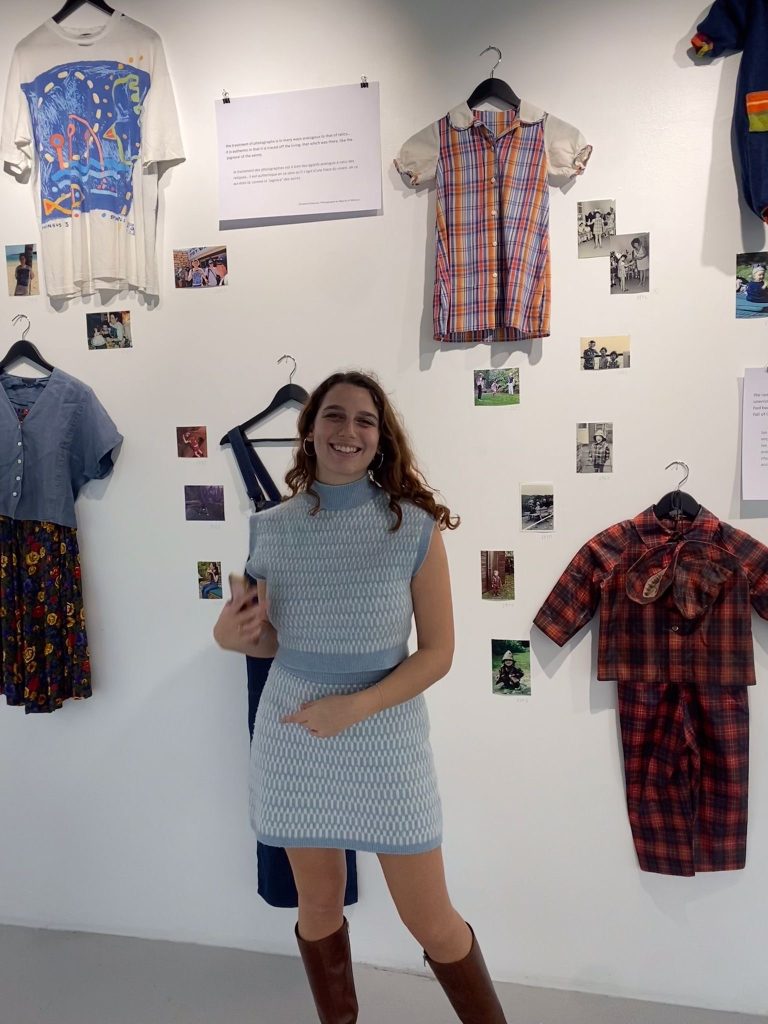A conversation with alumni Steph Lever
We talked with Stephanie Lever, who graduated from Fashion Studies in 2022. With a background in English literature, she confesses that at the beginning, the masters felt intimidating because she was entering a different world. However, as time went on, she discovered that the program let her explore different avenues of research.

What did you focus on during your studies?
I focused on curation, exhibition-making, and museology. I’m interested in how exhibitions and installations can make knowledge accessible, in the questions of connecting theory with a visual, spatial experience, and how to present research in innovative and engaging ways.
Recently, you curated the exhibition Behind the Wardrobe Door: Family Relics and Traces of the Body in Galerie D. Can you share the idea behind this project?
The final form that the project took was quite far from my initial idea behind the project. It came from some research I had been doing about the Comtesse Castiglione, who is famous for her beauty and for taking this massive collection of elaborate ‘self’ portraits in the late 1800s. I learned that she also created molds or casts of fragments of her body, like her foot or elbow, to send them to her admirers. From there, I had the idea to curate something around the concept of the secular relic — how the body is transformed into something magical through its fragmentation and preservation and the emotion attached to it. The idea of looking at the fashion museum space as a sort of church-like space and the bodiless garments as relics was floated for a while before it developed into something more personal based on my family wardrobe. Primarily, this was down to curatorial necessity; I needed access to things that could be shown or made visually interestingly, and there needed to be a clear methodology. It became clear that trying to mix institutional and personal examples wouldn’t work. That being said, the core themes that I wanted to discuss remained intrinsic to the project: the power of emotion and the memory of the absent body to make objects mean something.
What were the challenges you encountered in doing the exhibition as a curator?
As I mentioned, one of the significant challenges was shifting my thinking to be more visual and spatial, which was different from how I usually think about developing research into a thesis, for example, an academic paper. I wanted to share my ideas through the staging and focus on creating a link between the visual and the theory. It was a serious balancing act to try and make something that both meant something from a research point of view and was exciting and engaging as an experience for the visitor. Another huge challenge for me was the practical aspects of curating a gallery exhibition. It was a steep learning curve, especially about digital tools, which I needed to learn about. Everything I put in the space had to be made, placed and thought about.
What was the best, most rewarding aspect of doing this exhibition?
I think the most rewarding aspect was watching people walk around the space and experience it. It was interesting seeing if people, for example, took the route that I had imagined, they would think about how their experience of the exhibition was maybe altered if they moved around it differently from the one I had imagined, notice which elements they engaged with the most, what people liked enough to take photographs of. Once the gallery doors are open, the exhibition is totally out of your hands — you can’t control how people will position themselves with it or understand it — it takes on its own life. Although it was, on one hand, so personal, it became clear that the ideas behind it are so universal; everyone related to it somehow.
We know that you are in the admission process of a Ph.D.; what are your motivations for pursuing one?
I am! One of my main motivations is that I feel like there’s a lot of work left to do in my research field, which I’m hopeful could have a valuable impact on fashion museology and exhibition-making. I also feel like doing a doctorate would be the perfect opportunity to experiment with academic techniques that are commonly found in Fashion Studies. After this exhibition, I’m excited about the potential that I believe incorporating practice-based methodology into my research practice has to produce some interesting ideas. I want to explore that further, and I think a Ph.D. is a great space or structure for that.
Any advice for the students who want to follow an academic path after the MAFS?
I would say stay interested, keep reading, go to exhibitions, etc. because you never know where you might get your next idea or find something that interests you. Keep an eye out for calls for papers, and if you have an idea you’re passionate about, go for it.